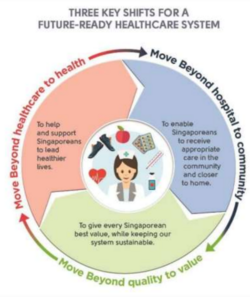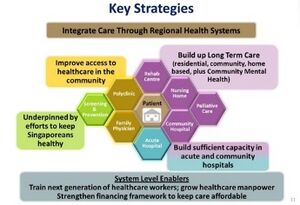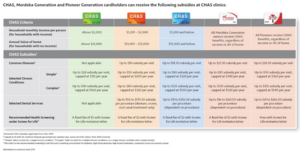Difference between revisions of "Group05 proposal"
| Line 41: | Line 41: | ||
Singapore’s strategy to ensure that healthcare accessibility and affordability is available for the majority of the population include: | Singapore’s strategy to ensure that healthcare accessibility and affordability is available for the majority of the population include: | ||
| − | # | + | # Improving access to healthcare in the community: Increase acute beds by 1,700 and community hospital beds to 3,000 by 2020, Investment in primary care infrastructure (polyclinics, community health centres) |
| − | # | + | # Enhancing key enablers including technology and manpower: Adding 30,000 more healthcare workers by 2020 and adopting digital technologies such as AI |
| − | # | + | # Strong financing policies to ensure healthcare costs remain affordable to the masses. This includes policy packages like the Pioneer Generation Package (subsidies for elderly medical care), MediShield Life (universal insurance coverage) and the Community Health Assistance Scheme (means-tested subsidies on primary care). |
[[File:Key strategies.jpg|thumb]] | [[File:Key strategies.jpg|thumb]] | ||
| Line 52: | Line 52: | ||
==Objective== | ==Objective== | ||
| − | To assess the status of Singapore’s accessibility to healthcare based whether the existing healthcare facilities and social support meets the demands of the poorer income groups and ageing population. Based on the results, we hope to conclude that either (a): There is no significant difference in accessibility despite geographical differences in income and age groups across the island or (b): there is significant difference in accessibility correlating to geographical differences in income and age groups across the island | + | To assess the status of Singapore’s accessibility to healthcare based whether the existing healthcare facilities and social support meets the demands of the poorer income groups and ageing population. Based on the results, we hope to conclude that either (a): There is no significant difference in accessibility despite geographical differences in income and age groups across the island or (b): there is significant difference in accessibility correlating to geographical differences in income and age groups across the island. |
===Visual Data Exploratory=== | ===Visual Data Exploratory=== | ||
| Line 61: | Line 61: | ||
* Explore availability of further social support including but not limited to Family Service Centres, Resident Centres. | * Explore availability of further social support including but not limited to Family Service Centres, Resident Centres. | ||
* To highlight primary care facilities with lower income social support such as CHAS, PG etc. | * To highlight primary care facilities with lower income social support such as CHAS, PG etc. | ||
| + | |||
| + | [[File:List of subsidies.png|thumb]] | ||
===Interactive Visualisation Result=== | ===Interactive Visualisation Result=== | ||
| Line 68: | Line 70: | ||
| − | == | + | ==Datasets Used== |
| − | + | * List of clinics & hospitals: http://hcidirectory.sg/hcidirectory/clinic.do?task=load | |
| − | + | * List of CHAS approved clinics: https://www.chas.sg/clinic_locator.aspx?id=90 | |
| + | * Resident Households by Planning Area and Monthly Household Income from Work: https://www.singstat.gov.sg/find-data/search-by-theme/population/geographic-distribution/latest-data > General Household survey > Resident Households > T152 | ||
| + | * Resident Households by Planning Area and Type of Dwelling: https://www.singstat.gov.sg/find-data/search-by-theme/population/geographic-distribution/latest-data > General Household survey > Resident Households > T148 | ||
==Reference== | ==Reference== | ||
| − | + | * The UK Healthcare system: http://assets.ce.columbia.edu/pdf/actu/actu-uk.pdf | |
| − | + | * The Hidden Costs of a Successful Developmental State: Prosperity and Paucity in Singapore: http://www.lse.ac.uk/international-development/Assets/Documents/PDFs/Dissertation/Prizewinning-Dissertations/PWD-2017/2018-ACY.pdf | |
| + | * Overview of the Health System and Regulatory Landscape in Singapore, 24th EPSO Conference26 September 2017, Adj Assoc Prof (Dr) Raymond ChuaGroup Director (Health Regulation Group), Ministry of Health | ||
| + | * https://www.aic.sg/care-services/Community%20Health%20Centres | ||
| + | * https://sph.unc.edu/nciph/gis/ | ||
| + | * https://www.mdpi.com/1660-4601/16/2/170 | ||
| + | * https://www.mdmag.com/medical-news/us-ranks-29th-in-global-healthcare-access-and-quality-index | ||
Revision as of 00:38, 8 March 2020
|
|
|
|
|
|
Contents
Abstract
The Ministry of Health (MOH) believes in ensuring quality and affordable basic medical services for all. Singapore’s healthcare system is designed to ensure that everyone has access to different levels of healthcare in a timely, cost-effective and seamless manner.
Despite the efforts mentioned above, there are growing signs of inequality in Singapore . Whilst social inequality can be measurable by many means, we will like to particularly highlight healthcare accessibility as a proxy for social inequality. We intend to test out whether the same standard of healthcare access is provided to all planning area/region in Singapore despite differences in income levels per planning area as well as whether there is appropriate healthcare coverage for the ageing population.
Background
Singapore's Healthcare at a glance
Singapore is one of the most developed state (measured by GDP per capita) in Asia and the world. Its healthcare spending per capita is also one of the highest in Asia and the World, which means that the majority of the population is likely to enjoy good quality healthcare. The Ministry of Health (MOH) believes in ensuring quality and affordable basic medical services for all. Singapore’s healthcare system is designed to ensure that everyone has access to different levels of healthcare in a timely, cost-effective and seamless manner.
Singapore’s strategy to ensure that healthcare accessibility and affordability is available for the majority of the population include:
- Improving access to healthcare in the community: Increase acute beds by 1,700 and community hospital beds to 3,000 by 2020, Investment in primary care infrastructure (polyclinics, community health centres)
- Enhancing key enablers including technology and manpower: Adding 30,000 more healthcare workers by 2020 and adopting digital technologies such as AI
- Strong financing policies to ensure healthcare costs remain affordable to the masses. This includes policy packages like the Pioneer Generation Package (subsidies for elderly medical care), MediShield Life (universal insurance coverage) and the Community Health Assistance Scheme (means-tested subsidies on primary care).
Motivation
Despite the efforts mentioned above, there are growing signs of inequality in Singapore. Whilst social inequality can be measurable by many means, we will like to particularly highlight healthcare accessibility as a proxy for social inequality. We intend to test out whether the same standard of healthcare access is provided to all planning area/region in Singapore despite differences in income levels per planning area as well as whether there is appropriate healthcare coverage for the ageing population.
Objective
To assess the status of Singapore’s accessibility to healthcare based whether the existing healthcare facilities and social support meets the demands of the poorer income groups and ageing population. Based on the results, we hope to conclude that either (a): There is no significant difference in accessibility despite geographical differences in income and age groups across the island or (b): there is significant difference in accessibility correlating to geographical differences in income and age groups across the island.
Visual Data Exploratory
- Develop a visual layout of Singapore’s wealth distribution (monthly household income) on a geospatial basis
- Layer on age distribution across the planning areas
- Develop a visual layout of Singapore’s healthcare network (primary, tertiary, community, aged homes) on a geospatial basis
- Explore mapping over elderly friendly zones / wheelchair friendly zones that allow elderly access to nearest healthcare facilities
- Explore availability of further social support including but not limited to Family Service Centres, Resident Centres.
- To highlight primary care facilities with lower income social support such as CHAS, PG etc.
Interactive Visualisation Result
Visualization Features
Datasets Used
- List of clinics & hospitals: http://hcidirectory.sg/hcidirectory/clinic.do?task=load
- List of CHAS approved clinics: https://www.chas.sg/clinic_locator.aspx?id=90
- Resident Households by Planning Area and Monthly Household Income from Work: https://www.singstat.gov.sg/find-data/search-by-theme/population/geographic-distribution/latest-data > General Household survey > Resident Households > T152
- Resident Households by Planning Area and Type of Dwelling: https://www.singstat.gov.sg/find-data/search-by-theme/population/geographic-distribution/latest-data > General Household survey > Resident Households > T148
Reference
- The UK Healthcare system: http://assets.ce.columbia.edu/pdf/actu/actu-uk.pdf
- The Hidden Costs of a Successful Developmental State: Prosperity and Paucity in Singapore: http://www.lse.ac.uk/international-development/Assets/Documents/PDFs/Dissertation/Prizewinning-Dissertations/PWD-2017/2018-ACY.pdf
- Overview of the Health System and Regulatory Landscape in Singapore, 24th EPSO Conference26 September 2017, Adj Assoc Prof (Dr) Raymond ChuaGroup Director (Health Regulation Group), Ministry of Health
- https://www.aic.sg/care-services/Community%20Health%20Centres
- https://sph.unc.edu/nciph/gis/
- https://www.mdpi.com/1660-4601/16/2/170
- https://www.mdmag.com/medical-news/us-ranks-29th-in-global-healthcare-access-and-quality-index



